The cast iron braiser is a remarkable kitchen tool that has gained popularity among home cooks and professional chefs alike. Its versatility and durability make it a preferred choice for preparing a variety of dishes, especially pasta dishes. In this comprehensive guide, we will explore the benefits of using a cast iron braiser, how it can enhance your pasta cooking experience, and much more.

Why Choose a Cast Iron Braiser for Pasta?
A cast iron braiser is not just any cooking vessel; it’s a game-changer when it comes to making pasta dishes. The even heat distribution and excellent heat retention of cast iron ensure that your pasta cooks perfectly every time. Whether you’re making a simple spaghetti or a complex lasagna, a cast iron braiser can handle it all.
Benefits of Using a Cast Iron Braiser
- Even Heat Distribution: Cast iron distributes heat evenly, reducing the risk of hot spots that can burn your food.
- Versatility: You can use it on the stovetop, in the oven, or even over a campfire.
- Durability: With proper care, a cast iron braiser can last a lifetime.
- Flavor Enhancement: The material can enhance the flavors of your dishes over time.
How to Use a Cast Iron Braiser for Pasta Dishes
Using a cast iron braiser is straightforward, but there are a few tips to keep in mind to get the best results. First, always preheat your braiser to ensure even cooking. Second, use a little extra oil or butter to prevent sticking, especially if your braiser is not well-seasoned.
Prepping Your Braiser
Before you start cooking, it’s essential to prep your braiser. Make sure it’s clean and dry. Apply a thin layer of oil to maintain its seasoning. This step is crucial for preventing rust and sticking.
Cooking Pasta in a Braiser
Cooking pasta in a cast iron braiser is a delight. The deep sides allow you to cook larger quantities without the risk of spilling. Additionally, the heat retention keeps the pasta warm longer, making it perfect for serving directly from the braiser.
Cleaning and Maintaining Your Cast Iron Braiser
Proper maintenance of your cast iron braiser is essential for its longevity. After each use, wash it with warm water and a soft sponge. Avoid using soap as it can strip the seasoning. Once clean, dry it thoroughly and apply a thin layer of oil.
Storage Tips
Store your braiser in a dry place to prevent rust. If you stack it, place a paper towel between the braiser and the lid to absorb moisture.
Recipe Ideas for Your Cast Iron Braiser
Here are some delicious pasta dishes you can try in your cast iron braiser:
- Classic Spaghetti Bolognese: The even heat distribution ensures a rich and flavorful sauce.
- Cheesy Lasagna: The deep sides of the braiser are perfect for layering.
- One-Pot Pasta Primavera: A quick and easy meal loaded with fresh vegetables.

FAQs About Cast Iron Braiser for Pasta Dishes
1. Can I use a cast iron braiser on an induction cooktop?
Yes, most cast iron braisers are compatible with induction cooktops. However, always check the manufacturer’s guidelines.
2. How do I restore the seasoning on my braiser?
If your braiser’s seasoning is wearing off, clean it thoroughly and apply a generous layer of oil. Bake it upside down in the oven at 350F for an hour.
3. Is a cast iron braiser heavy?
Yes, cast iron braisers are generally heavier than other cookware. However, their benefits far outweigh the inconvenience of their weight.
For more information on the differences between a braiser and other similar cookware, you can visit cast iron braiser vs saute pan. Additionally, detailed tips on maintaining your braiser can be found at cast iron braiser care tips. For an external perspective on cooking with braisers, check out this article.
This article contains affiliate links. We may earn a commission at no extra cost to you.

